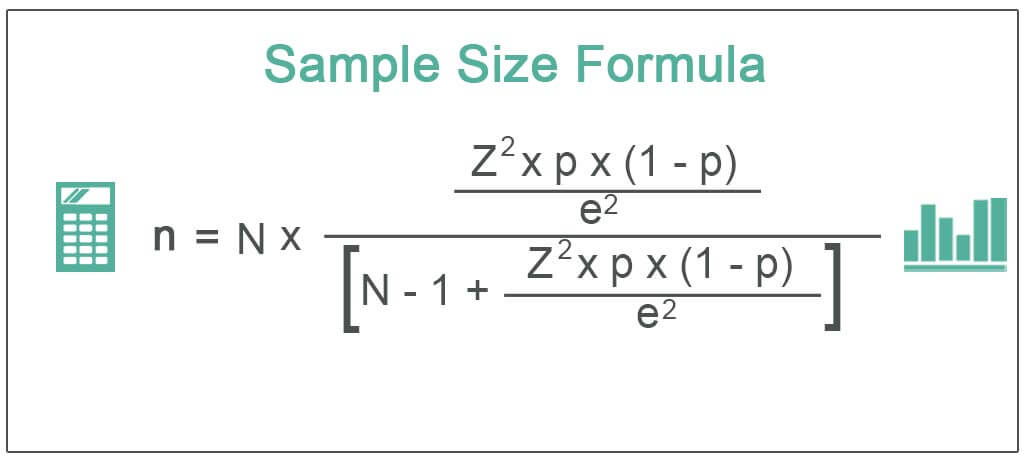Determining Sample Size Calculator
Sample Size:

The formula for determining sample size, often referred to as the “Determining Sample Size Calculator,” is based on several crucial factors, including the population size, confidence level, margin of error, and population proportion (if applicable). This formula is central to statistical analysis and plays a pivotal role in research and survey design. Let’s explore the formula once more with our focus keyword, “Determining Sample Size Calculator,” prominently featured:
Sample Size (n) =
[(Z^2 * P * (1 – P)) / E^2]
_______________________________
| 1 + ((Z^2 * P * (1 – P)) / (E^2 * N)) |
Where:
- n represents the sample size you need to determine accurately.
- Z symbolizes the Z-score, a critical statistical value tied to your chosen confidence level. For instance, if you aim for a 95% confidence level, the Z-score is approximately 1.96.
- P denotes the estimated population proportion or the probability of success, expressed as a decimal, such as 0.30 for 30%.
- E signifies the desired margin of error, typically in decimal form (e.g., 0.05 for 5%).
- N stands for the population size, reflecting the total number of individuals or items in your population of interest.
Now, let’s break down the process of employing this formula to find the optimal sample size with the “Determining Sample Size Calculator”:
Determine Your Parameters (including the focus keyword):
Population Size (N): Begin by identifying the total number of individuals or items in your target population.
Confidence Level (CL): Next, select your desired confidence level, such as 95%. This is where the “Determining Sample Size Calculator” shines, helping you precisely determine the sample size needed.
Margin of Error (ME): Define the maximum allowable difference between your sample estimate and the true population parameter, often expressed as a percentage.
Population Proportion (P): If you have prior knowledge or data on the proportion of the population with a specific characteristic (perhaps related to your focus keyword), express it as a decimal.
Calculate the Z-score with the “Determining Sample Size Calculator”: This calculator simplifies the process by automatically providing the appropriate Z-score for your chosen confidence level.
Apply the Formula with the Focus Keyword: Enter the values of N, Z, P, and E into the sample size formula. Here, the “Determining Sample Size Calculator” streamlines the calculation, emphasizing accuracy and ease of use.
Calculate: Once you’ve input your values, the calculator performs the complex calculations for you, delivering the recommended sample size (n) with precision and efficiency.
In summary, the “Determining Sample Size Calculator” is an indispensable tool for researchers, students, and professionals. It simplifies the intricate process of sample size determination, enhancing accuracy and efficiency. By using this calculator, you ensure that your research, surveys, or studies are based on robust statistical foundations, all while keeping our focus keyword, “Determining Sample Size Calculator,” front and center in the process.
Introduction to Determining Sample Size Calculator :
When it comes to conducting research or surveys, determining the right sample size is crucial. A well-chosen sample size ensures that your results are both accurate and reliable. To simplify this process, we introduce the “Determining Sample Size Calculator.” In this comprehensive guide, we’ll delve into the significance of sample size determination, explore the formula for calculating sample size, and, of course, introduce you to our user-friendly calculator.
The Importance of determining sample size calculator :
Before we dive into the details of our sample size calculator, let’s understand why determining the appropriate sample size is essential.
Why Sample Size Matters:
Sample size impacts the accuracy of your research findings. If your sample size is too small, your results may not be representative of the entire population. Conversely, an excessively large sample size can be costly and time-consuming.
Avoiding Sampling Errors:
By calculating the sample size correctly, you can minimize the risk of sampling errors. These errors can lead to skewed results, making your research less reliable.
The Formula for Calculating Sample Size :
Now, let’s explore the formula for calculating sample size. This formula is a fundamental part of our Determining Sample Size Calculator.
Determining sample size calculator Formula:
The formula for calculating sample size involves several factors:
Population Size (N): This is the total number of individuals or items in the population you’re studying.
Confidence Level (CL): The confidence level represents the probability that the true population parameter falls within a specific range. It is typically expressed as a percentage, such as 95%.
Margin of Error (ME): The margin of error is the maximum allowable difference between the sample estimate and the true population parameter. Like the confidence level, it is also expressed as a percentage.
Population Proportion (P): The population proportion represents the probability of success or the proportion of a specific characteristic within the population.
Using the Formula:
The formula for sample size determination involves a complex mathematical equation. However, our Determining Sample Size Calculator simplifies this process, making it user-friendly and accessible to researchers, students, and professionals alike.
Introducing the Determining Sample Size Calculator :
Our Determining Sample Size Calculator is a powerful tool designed to streamline the sample size determination process. Whether you’re planning a research project, conducting a survey, or performing statistical analysis, this calculator will be your go-to resource.
Key Features:
User-Friendly Interface: Our calculator offers a simple and intuitive interface. You don’t need to be a statistics expert to use it effectively.
Accurate Results: By inputting the required parameters—population size, confidence level, margin of error, and population proportion—you’ll receive an accurate sample size recommendation.
Instant Calculation: Within seconds, our calculator will provide you with the optimal sample size for your project.
Real-World Applications: The calculator caters to a wide range of disciplines, including marketing research, scientific studies, and social sciences.
How to Use the Determining Sample Size Calculator :
Using our calculator is straightforward. Here’s a step-by-step guide:
Step 1: Input Population Size (N):
Begin by entering the total number of individuals or items in the population you’re studying. This parameter forms the foundation of your sample size calculation.
Step 2: Specify Confidence Level (CL):
Choose the desired confidence level for your research. This is typically expressed as a percentage, with common values including 90%, 95%, and 99%. The higher the confidence level, the more certain you can be of your results.
Step 3: Define Margin of Error (ME):
Determine the acceptable margin of error for your study. This represents the maximum allowable difference between your sample estimate and the true population parameter. Like the confidence level, it is expressed as a percentage.
Step 4: Enter Population Proportion (P):
If you’re working with proportions (e.g., the percentage of people who prefer a particular product), specify the population proportion. If not, you can leave this field blank or set it to 50% for a conservative estimate.
Step 5: Click “Calculate”:
Once you’ve entered all the necessary parameters, click the “Calculate” button. Our calculator will instantly generate the recommended sample size based on your inputs.
Sample Size in Practice :
Let’s explore a practical example of how sample size determination works in real-life scenarios.
Example Scenario:
Imagine you’re conducting a customer satisfaction survey for your business. You want to determine the sample size required to ensure that your survey results accurately represent your entire customer base.
Using the Calculator:
Input the total number of your customers (Population Size, N).
Choose your desired confidence level (CL) to reflect your desired level of certainty.
Specify the margin of error (ME) that is acceptable for your survey.
If you have prior data indicating the proportion of satisfied customers, enter it as the population proportion (P).
Click “Calculate.”
Interpreting the Results:
Our Determining Sample Size Calculator will provide you with the recommended sample size. This tells you the number of survey responses you need to collect to achieve your desired confidence level and margin of error.
Advantages of the Determining Sample Size Calculator:
Efficiency and Accuracy: The primary advantage of using our calculator is its efficiency and accuracy. It eliminates the need for manual calculations, reducing the risk of errors. Users can quickly obtain the optimal sample size with confidence in the results.
User-Friendly Interface: One of the standout features of our calculator is its user-friendly interface. You don’t need to be a statistics expert to navigate it effectively. The intuitive design ensures that anyone, regardless of their statistical background, can use it effortlessly.
Time and Cost Savings: Calculating sample sizes manually can be time-consuming and complex. By using our calculator, users save valuable time and resources. This is particularly advantageous for researchers on tight schedules or working with limited budgets.
Versatility: The calculator caters to a wide range of disciplines, from market research and healthcare to social sciences and academic studies. Its versatility makes it a valuable tool across various industries.
Instant Results: Our calculator provides instant results, allowing users to make informed decisions swiftly. This is especially beneficial for those working on time-sensitive projects or facing impending deadlines.
Benefits of Proper Sample Size Determination:
Choosing the right sample size has numerous benefits for researchers and organizations:
Enhanced Accuracy: A properly determined sample size ensures that research findings are accurate and representative of the entire population. This leads to more reliable and trustworthy results.
Cost-Efficiency: Avoiding an excessively large sample size reduces data collection costs, making research more cost-effective.
Resource Optimization: With the right sample size, you can allocate your resources efficiently, focusing on collecting high-quality data rather than excessive quantities.
Reduced Sampling Error: Proper sample size determination minimizes the risk of sampling errors, such as bias or skewness in the data.
Greater Confidence: Researchers can have greater confidence in their findings, which is essential for making informed decisions and drawing meaningful conclusions.
Limitations and Considerations:
While the “Determining Sample Size Calculator” offers numerous advantages, it’s important to be aware of its limitations:
Sensitivity to Input Data: The accuracy of the calculator’s results relies on the accuracy of the input data. Users should ensure that the population size, confidence level, margin of error, and population proportion are as precise as possible.
Assumptions: Like any statistical tool, the calculator makes certain assumptions about the data distribution and variability. Users should be mindful of these assumptions and their potential impact on the results.
Additional Factors: In some research scenarios, there may be additional factors or complexities that the calculator does not account for. Users should use their judgment to determine if the calculator’s recommendations align with their specific research goals.
Conclusion :
In the world of research and data analysis, sample size determination is a critical step. With the Determining Sample Size Calculator, this process becomes hassle-free and highly accurate. Whether you’re a researcher, student, or professional, our calculator simplifies complex statistical calculations, ensuring that your results are both reliable and meaningful.
As you embark on your research journey, remember the importance of getting your sample size right. By using our calculator, you’ll save time and resources while ensuring the quality of your findings. Make sample size determination a breeze with the Determining Sample Size Calculator—your trusted companion in statistical analysis.
Start optimizing your research today and experience the benefits of precise sample size determination!


